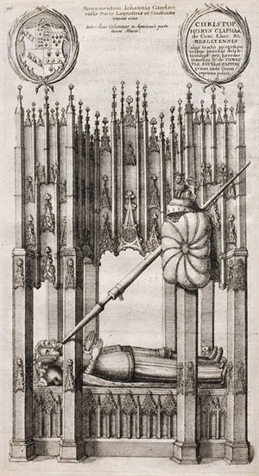Blanche’s importance in JoG’s life can’t really be overstated. She and her sister Maud were co-heiresses of their father Henry of Grosmont, first duke of Lancaster. When her father and sister died in quick succession in 1361-62, Blanche and her husband John of Gaunt, the son of Edward III, inherited the whole thing. Edward III made JoG duke of Lancaster in his own right, and the Lancastrian inheritance made him the wealthiest, most powerful citizen in England. Blanche was also the mother of JoG’s only male heir. Moreover, there’s a lot of evidence to suggest that John and Blanche had an affectionate, loving relationship. To say that he owed a lot to Blanche would be a huge understatement.
The account tells us of a feast held at the Savoy, the Lancastrian’s lavish London residence, where 38 chickens, 9 pigeons, 3 pigs, 11 geese, beef, mutton, beer, and wine were all consumed. It gives us interesting details about the service itself, which involved draping St Paul’s in black cloths and paying 24 paupers to stand around the tomb holding candles. My favourite bit details the sweets that JoG served to the staff of St Paul’s the night before:
Item in 2 lbs. of ginger comfits
And 2 lbs. of anise comfits
2 lbs. of gobbet royal (a type of sweetmeat)
2 lbs. of cloves
2 lbs. of sugar-plate (hardened sugar, often flavoured with flower petals)
2 lbs. of large dragée (a comfit that often contained a seed in the middle), at 18 d. per lb.
1 lb. of flower of cinnamon comfits
1 lb. of clove comfits at 2 s. per lb.
All obtained and consumed by the magnates and by the chapter of St. Paul’s, London, on the vigil of the anniversary in the usual manner after vespers of the dead, 22 s.
It’s not only interesting as a showcase of the medieval sweet-tooth (which was clearly large) , but it also speaks to the secret motivation behind the annual memorials. These sweets are a statement of wealth – few people could afford to serve things like this. Few of the staff at St Paul’s would have tasted candy this delicious on a regular basis. And that’s where it gets interesting to me.
While Westminster Abbey was a church for kings, St Paul’s was a cathedral for the people of London. Its preachers were in a position to influence public opinion, and I think the Lancastrians – especially, but not only, JoG – took advantage of this. John of Gaunt was famously unpopular with Londoners, especially in the 1370s and 1380s, and I think we have to interpret feasts like this one as attempts to keep the cathedral staff on side.
Is it a bit cynical? Yes. Does it mean that we have to forget the notion that John of Gaunt was crazy about his first wife and grieved her death? No. But I think there’s room for a more nuanced interpretation.

 RSS Feed
RSS Feed